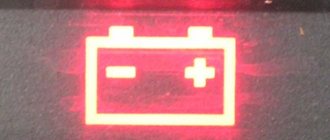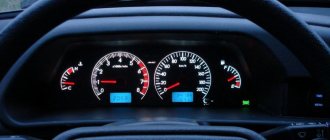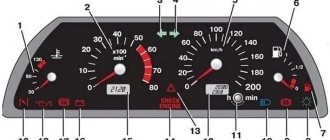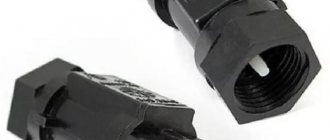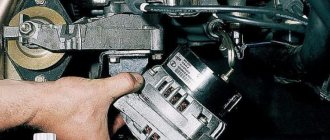- The parking light indicator of the VAZ Priora is flashing on the instrument panel - 10 answers
- Battery lights up on devices in Priora - 5 answers
- Devices stopped working after replacing the backlight bulbs - 3 answers
- The rpm needle rises when the ignition is turned on - 3 answers
- Coolant temperature sensor in a Priora with air conditioning, why is it acting up? – 2 answers
Electric power steering indicator (optional) - lights up orange when the ignition is turned on and goes out after the engine starts (the more the car's wheels are turned when the ignition is turned on, the longer the indicator does not go out.
Check the brake fluid level, top up.
If icon 14 is electric power steering. After starting the engine, it should go out, and if it lights up after starting, this is a malfunction of the electric booster.
Details if needed.
23 ABS fault warning lamp
Subscribe
to our channel in
Index.Zen
Even more useful tips in a convenient format
Tachometer, speedometer, on-board computer indicators, light bulbs - all these components are located on the Lada instrument panel. The “tidy” is designed to display the current state of various Lada Priora systems. An experienced motorist will immediately notice that one of the components requires repair; a certain icon will inform him about this. If you are a novice driver, then it will be useful for you to study the Lada Priora dashboard. This material provides a detailed description of each element of the tidy.
An exclamation mark is lit on the dashboard: what should the driver do?
According to experts, faults in electronics can also cause indexing. Icons may appear involuntarily on the dashboard due to the following breakdowns:
- if the contacts succumb to the oxidation process;
- if the terminals change their location;
- if breakdowns occur in the on-board car computer.
Taking into account the advice of experts, and in order not to harm one of the car systems, you need to check the functionality of electronic components. To do this, you will need to diagnose the electronic part, which is done quite easily - remove the dashboard and check the location of the terminals in the so-called sockets.
As a rule, among the main icons it is customary to highlight the engine “check”, the Airbag icon in the form of a man fastened with a belt, the spiral of glow plugs for a diesel engine, the oil pressure drop indicator in the form of an oil can with a drop, as well as the engine overheating icon, which is usually made in the form of a thermometer with waves.
Also on many cars an important indicator is the exclamation mark. Normally, after starting the engine and performing self-diagnosis, all warning and emergency symbols should go out after a few seconds.
In some cases, if a malfunction occurs, in addition to the exclamation mark, icons on the car’s dashboard light up. In others, apart from this sign, nothing may light up. So, if the red icon (!) is lit on the panel, then this often indicates
problems with the brake system
.
Typically, this indicator lights up when the level of brake fluid in the reservoir drops significantly. This indicates that the system is not tight, which is unacceptable. It is not difficult to guess that such problems with brakes require immediate diagnosis. Moreover, operating a car with a glowing red exclamation mark on the dashboard in such a situation is prohibited!
However, the brakes may be fine, although the indicated error on the dashboard may be present. For this reason, you need to know why else the exclamation mark on the instrument panel may be on besides the low brake fluid level.
- If the sign is in a circle and parentheses, then it is brakes. In the case where the exclamation mark and the ABS sign are lit in parallel, the problem is usually a faulty ABS.
- If the exclamation point is in the yellow triangle, there is a malfunction in the electronic stabilization system.
- A red triangle with an exclamation mark may indicate various breakdowns and the need for diagnostics, that is, you need to carefully examine the instrument panel and see if any other icons are lit.
Please note that often the culprit for this indicator to light up may be a sensor failure, wiring problems or poor contacts. For example, the GTZ sensor connector on the master brake cylinder, broken wiring, damage or open circuit. The brake fluid level sensor may also be faulty. It also happens that problems arise with the instrument panel itself.
Taking into account the fact that there may be several reasons, with the brakes being the most serious, let us dwell on this problem in more detail. If the exclamation mark is on on the panel, the first step is to check the brake fluid level in the reservoir.
To do this, just put the car on a level surface, unscrew the tank cap and make sure that the level is between o and “max”. If the level is below the minimum mark, then the exclamation mark on the panel lights up based on a signal from the sensor.
In the case where the driver recently checked the level, and now there has been a sharp decrease, it is important to find the cause of the leakage of fuel fluid from the system. This could be brake hoses, hydraulic clutch, brake cylinders, etc.
It also happens that the indicator lights up while driving over bumps, and then goes out on a smooth road. This means that there is little liquid in the tank, but the level has not yet dropped to a critical level. When the car rocks, the sensor is triggered, while on a flat surface the level of brake fluid is still sufficient for the indicator to go out.
Icon for turning on external lighting devices (headlights)
A green or yellow indicator in the form of a crossed out lamp or a light bulb with an exclamation mark indicates a malfunction of one of the external lighting sources (low or high beam). If the element itself is intact, then the reason must be sought in the wiring or safety devices.
High beam in the car is activated
Automatic switching between low and high beams switched on
Yellow headlight direction icons indicate a malfunction in the functioning of the automatic headlight angle adjustment mechanism
A yellow indicator with the words “AFS OFF” indicates that the adaptive headlights mechanism is deactivated. If one of these icons blinks, it means that one of the devices is malfunctioning.
Green indicators in the form of a headlight or the inscription “DRL” appear when the system for automatically activating low-beam headlights is turned on during the daytime
The yellow icon in the form of a car with its optics turned on is associated with problems detected in the functioning of one or more brake light bulbs or taillights. If the lamps are working properly, the appearance of the indicator warns of damaged wiring or a broken relay fuse.
Green headlights indicate activation of side lighting sources. Icon of switched on fog lights
Two green arrows pointing in different directions indicate activation of the turn signal or light alarm
Panel malfunctions: signs and causes
What malfunctions can occur in the operation of the control panel:
- The backlight does not light up. There may be several reasons - damage to the device’s power supply circuit, a short circuit in the system, failure of the control panel. But one of the most common reasons in this case is the burnout of the safety device. The marking fuse F10 is located in the mounting block; it must be checked first.
- The sensors do not work - the arrows on the speedometer and tachometer do not rise. The reason may be a bad signal coming from the speed sensor or crankshaft sensor to the dashboard. It is necessary to check the electrical circuit for breaks. Much less often the problem lies in a failed sensor.
- The controller for the volume of gasoline in the tank and the engine temperature do not work. As in the previous case, the cause of the malfunction may lie directly in the sensors themselves. The fuel volume controller is located in the tank with the fuel pump, and the coolant sensor is located in the cylinder head. Before replacing, we recommend checking the quality of the connection and contacts - perhaps they are simply damaged or oxidized, as a result of which the sensors do not work. The reason may also be a damaged electrical circuit; in this case, you will need to check the wiring.
- It happens that the dashboard as a whole works correctly, but the controllers transmit incorrect information. The reason may lie in the performance of the processor or a short circuit in the wiring. Sometimes the problem lies in bad mass.
- The backlight is partially not working. Most likely, the reason lies in the burnout of the lighting sources; they will need to be replaced (the author of the video is the channel In Sandro’s Garage).
Warning icons on the panel
The steering wheel icon can light up in two colors. If the yellow steering wheel is on, then adaptation is required, and when a red image of the steering wheel with an exclamation mark appears, you should already be concerned about the failure of the power steering or power steering system. When the red steering wheel lights up, your steering wheel will probably become very difficult to turn.
The immobilizer icon usually blinks if the car is locked; in this case, the indicator of a red car with a white key signals the operation of the anti-theft system. But there are 3 main reasons if the immo light is constantly on: the immobilizer is not activated, if the tag on the key is not read or the anti-theft system is faulty.
The handbrake icon lights up not only when the handbrake lever is activated (raised), but also in cases where the brake pads are worn out or the brake fluid needs to be topped up/replaced. On a car with an electronic handbrake, the parking brake light may come on due to a glitch in the limit switch or sensor.
The coolant icon has several options and depending on which one is lit, draw conclusions about the problem accordingly. One red lamp with a thermometer scale indicates an increased temperature in the engine cooling system, but a yellow expansion tank with waves indicates a low coolant level in the system.
The washer icon indicates a low fluid level in the windshield washer reservoir. Such an indicator lights up not only when the level actually decreases, but also if the level sensor is clogged (the sensor contacts become coated due to poor-quality liquid), giving a false signal. On some vehicles, the level sensor is triggered when the washer fluid does not meet specifications.
The ASR icon is an Anti-Spin Regulation indicator. The electronic unit of this system works in tandem with ABS sensors. When such a light is constantly on, it means the ASR is not working. On different cars, such an icon may look different, but often in the form of an exclamation mark in a triangle with an arrow around it or the inscription itself, or in the form of a car on a slippery road.
The catalyst icon often lights up when the catalytic element overheats and is quite often accompanied by a sharp drop in engine power. Such overheating can occur not only due to poor cell throughput, but also if problems arise in the ignition system. When the catalyst fails, high fuel consumption will be added to the burning light.
The exhaust gases icon, according to information from the manual, indicates a malfunction in the exhaust gas purification system, but, as a rule, such a light starts to light after poor refueling or the presence of an error in the lambda probe sensor. The system registers misfires of the mixture, as a result of which the content of harmful substances in the exhaust gases increases and, as a result, the “exhaust gases” light comes on on the dashboard. The problem is not critical, but diagnostics are worth doing to find out the cause.
Dashboard indicator symbols
When starting up, almost all the icons on the dashboard light up - this way the operation of the light bulbs is checked. Some drivers believe that these are messages about malfunctions of some Lada Priora systems.
| No. on the diagram | Indicator designations |
| 1 | Tachometer. The device measures the engine crankshaft frequency (revolutions per minute). If the arrow goes beyond the red value, it means that the Lada Priora engine is operating in a dangerous mode; |
| 2 | Brake force distributor indicator. Reports defects in the operation of this node; |
| 3 | Battery charge. If the lamp lights up while the engine is running, the battery is discharged; |
| 4 | Left turn signal. The sign flashes when there is an alarm or the left indicator is on; |
| 5 | Speedometer. The device reports the speed at which your Lada Priora is currently moving; |
| 6 | Emergency lubricant pressure in the engine. If the sign lights up during operation of the power plant, it means the pressure in the system is low; it is highly not recommended to operate the engine in this condition; |
| 7 | Right turn signal (see No. 4); |
| 8 | Handbrake indicator. Lights up yellow if the Lada Priora is in the handbrake; |
| 9 | Antifreeze temperature in the cooling system. The operating temperature of the motor starts from 90° and above to the red mark. If overheating occurs, turn off the engine; |
| 10 | Gasoline level in the tank. If the fuel level approaches the minimum, the fuel pump may break; |
| 11 | Reserve gasoline level. The indicator lights up when there are less than 10 liters left; |
| 12 | Key for resetting the daily mileage and switching between display modes; |
| 13 | Alarm. If you have triggered the emergency lights, the lamp will flash along with the turn signal arrows; |
| 14 | Malfunctions in the electric amplifier. If defects appear in the EUR, the lamp will light up while the engine is running; |
| 15 | High beam designation. An active indicator indicates that you have switched to distant; |
| 16 | Outdoor Lighting. The system notifies the driver about the operation of the headlights or low beams; |
| 17 | Airbag malfunctions. If the lamp lights up after starting, then there is a high probability that the airbags will not deploy in a collision; |
| 18 | Immobilizer. An audible signal and flashing indicate that the immobilizer system is faulty; |
| 19 | Computer screen. Here you can view information from the bookmaker, as well as find out the total and daily mileage; |
| 20 | Indication of unfastened seat belts. The buzzer will signal a violation for 90 seconds; |
| 21 | The brake system is in disrepair. Most often these are worn pads or insufficient fluid in the system; |
| 22 | Disabling a specific airbag; |
| 23 | Indicator of defects in ASB operation, the braking system is operating normally; |
| 24 | Check Engine – there is a breakdown in the engines; diagnostics and subsequent repairs are urgently required. |
Reporting a malfunction
The battery icon lights up if the voltage in the on-board network drops; often this problem is associated with a lack of battery charge from the generator, so it can also be called the “alternator icon”. On vehicles with a hybrid engine, this indicator is supplemented by the inscription “MAIN” at the bottom.
The oil icon, also known as a red oil can, indicates a drop in the oil level in the car engine. This icon lights up when you start the engine, and does not go out after a few seconds or may light up while driving. This fact indicates problems in the lubrication system or a drop in oil level or pressure.
The airbag icon can light up in several ways: either the red inscription SRS and AIRBAG, or “a red man wearing a seat belt,” with a circle in front of him. When one of these airbag icons lights up on the panel, the on-board computer notifies you of a malfunction in the passive safety system, and in the event of an accident, the airbags will not deploy.
The handbrake is up, the brake pads are worn out or the brake fluid level is low. A low level is precisely what poses a danger, because the reason may not only be in heavily worn pads, as a result of which, when you press the pedal, the fluid disperses throughout the system, and the float gives a signal about a low level, the brake hose may be damaged somewhere, and this is much more serious.
An exclamation mark can also light up in the form of an “attention” sign, both on a red and yellow background. When the yellow “attention” sign lights up, it informs about a malfunction in the electronic stabilization system, and if it is on a red background, it simply warns the driver about something, and, as a rule, explanatory text is displayed on the dashboard display or combined with other informative text designation.
The ABS icon may have several display options on the dashboard, but regardless of this, it means the same thing on all cars - a problem has occurred in the ABS system, and that the anti-lock wheel system is not working at the moment. You can find out the reasons why ABS does not work in our article. In this case, movement can be made, but there is no need to rely on the ABS to activate; the brakes will operate as usual.
The ESP icon may either light up intermittently or stay on constantly. A light with this inscription indicates problems with the stabilization system. The Electronic Stability Program indicator, as a rule, lights up for one of two reasons - either the rotation angle sensor has failed, or the brake light sensor (aka “frog”) has died for a long time. Although, there can be a more serious problem, for example, the brake system pressure sensor is covered.
The engine icon, some drivers may call it the “injector icon” or check, may glow yellow when the engine is running. It informs about the presence of engine errors and malfunctions of its electronic systems. To determine the reason for its appearance on the dashboard display, self-diagnosis or computer diagnostics are performed.
The glow plug icon may light up on the dashboard of a diesel car; the meaning of such an indicator is exactly the same as the “check” icon on gasoline cars. When there are no errors in the electronic unit’s memory, the spiral icon should go out after the engine warms up and the glow plugs are turned off. Read how to check glow plugs here.
This material is informative for most car owners. And although absolutely all possible icons of all existing cars are not presented here, you will be able to independently understand the main symbols of the car’s dashboard, and will not sound the alarm when you see that the icon on the panel is on again.
An exclamation mark lights up on the dashboard: what actions should car owners take?
Having ruled out a low level of fuel fluid, in the process of identifying a problematic element (sensor or wiring), you can quickly check the operation of the sensor and wiring right on the spot. It's not difficult to do this. It is enough to press the rubber seal of the tank lid, thereby lowering the sensor float. If the sensor is working properly, the exclamation mark on the panel should light up.
If the indicator does not light, then it is enough to take a small piece of copper wire, remove the power from the brake fluid level sensor and close the sensor power contacts on the wiring with the prepared wire. After the circuit closes, the low brake fluid level signal should light up. If the icon is not lit, there is a high probability of problems with the wiring.
Before you begin troubleshooting problems indicated by an exclamation mark that lights up on the instrument panel in a Priora, you should determine:
- where will it light up?
- what the icon will represent.
An icon can have multiple images:
- If a red exclamation mark starts to burn at the bottom of the circle, this will indicate a problem with the brake system, namely the minimum level of brake fluid. This problem can be solved quite simply by adding brake fluid to a special reservoir to the required level. If after this the indicator light continues to light, then experts advise checking the serviceability of all components of the brake system.
- If a red exclamation mark starts to light up in the triangle at the top of the circle on the Priora’s instrument panel, this will indicate a problem with the car’s brake force distributor. It is worth noting that the most modern models use not a circle, but a triangle. Only experienced specialists can fix this problem, so you need to visit a service station as soon as possible. And when driving, if you see that the light in the triangle has begun to light, you should be extremely careful.
- If the red exclamation mark, located at the bottom of the steering wheel icon, stays on for a long time, this will indicate a malfunction in the EPS (electric power steering wheel).
If the car owner sees that the light comes on while the engine is running, then first of all you need to check the functionality of the car's brake force distributor.
Let's sum it up
As you can see, the exclamation mark (!) on the instrument panel is lit for various reasons. Taking into account the fact that on different cars such an indicator can light up in different colors (yellow or red), it is important to be able to accurately determine the cause.
https://www.youtube.com/watch?v=qBViROjeqJU
In most cases, a similar red icon in a circle means that there are problems with the brake system. The yellow color may indicate wear on the brake pads, that is, the icon of this color is informational.
In any case, the brake system in such a situation and regardless of the color of the indicator needs diagnostics. If necessary, maintenance or repairs are performed. If the reason for the indicator to light up is a malfunction of the brake fluid level sensor, the sensor needs to be replaced. By the way, on many cars you can only replace the float if it is the problem.
If two icons are lit, “exclamation mark” and ABS
This often happens when two icons light up on the instrument panel at once, for example, an “exclamation mark” and an ABS icon (or a stabilization system icon in the form of a “car on a crooked path”).
Since the car’s braking system is often very closely connected with the ABS system (Anti-lock Braking System) and the motion stabilization system, if a malfunction occurs in one of these systems, the second may also stop working and/or be forced to turn off on-board computer. Therefore, if two icons appear on the instrument panel at once, you will have to look for a fault in two systems at once.
If, after troubleshooting the brake system, the icons on the panel do not disappear, then you will have to look for it in the ABS system (or stabilization system). However, it is necessary to make a reservation that it is very unlikely to find a malfunction in the ABS or stabilization system by simple inspection, so if two icons appear at once, it is best to immediately contact a car service center (or read the errors yourself).
